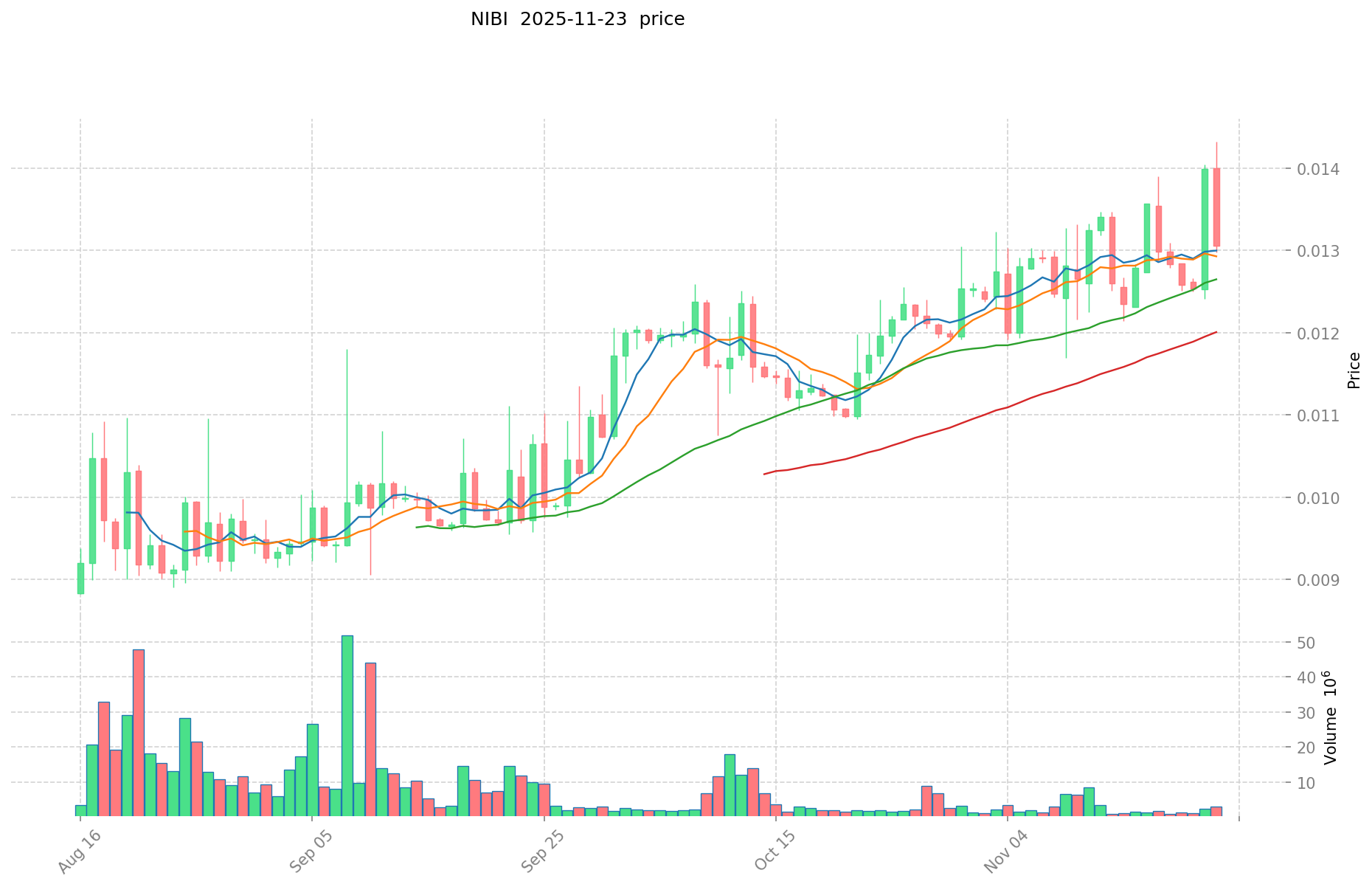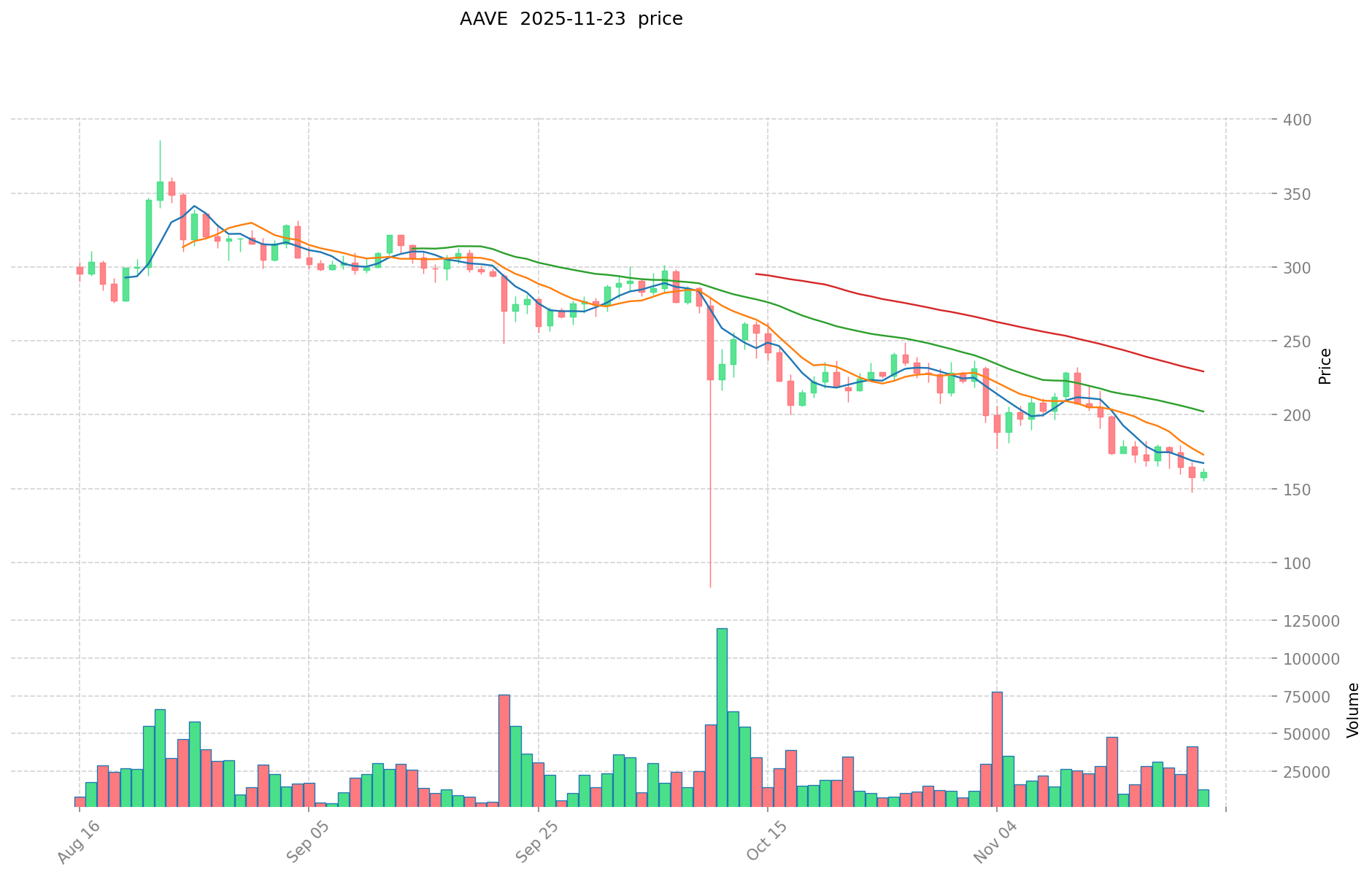NIBI vs AAVE: Exploring the Linguistic Landscape of Digital Communication
Introduction: Investment Comparison of NIBI vs AAVE
In the cryptocurrency market, the comparison between Nibiru Chain vs AAVE has always been a topic that investors cannot ignore. The two not only have significant differences in market cap ranking, application scenarios, and price performance, but also represent different cryptocurrency asset positions.
Nibiru Chain (NIBI): Since its launch, it has gained market recognition for its positioning as a breakthrough L1 blockchain and smart contract ecosystem.
AAVE (AAVE): Since its inception in 2020, it has been hailed as an open-source decentralized lending protocol, becoming one of the cryptocurrencies with the highest global trading volume and market capitalization.
This article will comprehensively analyze the investment value comparison between Nibiru Chain vs AAVE, focusing on historical price trends, supply mechanisms, institutional adoption, technological ecosystems, and future predictions, attempting to answer the question most concerning investors:
"Which is the better buy right now?"
I. Price History Comparison and Current Market Status
NIBI (Coin A) and AAVE (Coin B) Historical Price Trends
- 2024: NIBI reached its all-time high of $1.032 on March 12, 2024.
- 2025: NIBI hit its all-time low of $0.008219 on August 14, 2025.
- Comparative Analysis: Over the past year, NIBI has experienced a significant drop of 64.48% from its peak, while AAVE has shown more stability with only a 1.98% decrease.
Current Market Situation (2025-11-24)
- NIBI current price: $0.014029
- AAVE current price: $170.49
- 24-hour trading volume: $115,906.77 (NIBI) vs $2,434,615.80 (AAVE)
- Market Sentiment Index (Fear & Greed Index): 13 (Extreme Fear)
Click to view real-time prices:
- Check NIBI current price Market Price
- Check AAVE current price Market Price


II. Core Factors Affecting the Investment Value of NIBI vs AAVE
Supply Mechanisms Comparison (Tokenomics)
- NIBI: Fixed total supply with deflationary mechanisms, burn events reduce circulating supply over time
- AAVE: Inflationary model with staking rewards, total supply increases based on protocol governance decisions
- 📌 Historical pattern: Deflationary tokens like NIBI tend to experience price appreciation during bull markets, while AAVE's value is more tied to protocol revenue and governance participation.
Institutional Adoption and Market Applications
- Institutional holdings: AAVE has gained more institutional adoption due to its established lending protocol and longer market presence
- Enterprise adoption: AAVE has stronger integration within DeFi infrastructure as a lending standard, while NIBI is primarily used for trading and liquidity provision
- Regulatory attitudes: Both face similar regulatory scrutiny in most jurisdictions, though AAVE's utility focus may provide regulatory advantages
Technical Development and Ecosystem Building
- NIBI technical upgrades: Cross-chain functionality expansion and improved transaction throughput
- AAVE technical development: V3 protocol with improved capital efficiency, risk management, and layer-2 integrations
- Ecosystem comparison: AAVE has a more developed DeFi ecosystem with established lending markets across multiple blockchains, while NIBI is working to expand its utility beyond basic transactions
Macroeconomic Factors and Market Cycles
- Inflation performance: Both assets have shown volatility during inflationary periods, with neither demonstrating clear superiority as inflation hedges
- Monetary policy impacts: Interest rate hikes tend to negatively affect both assets, though AAVE's lending utility provides some offsetting benefits in high-rate environments
- Geopolitical factors: Cross-border transaction demand benefits both tokens, though regulatory crackdowns in certain jurisdictions can impact adoption
III. Price Prediction 2025-2030: NIBI vs AAVE
Short-term Prediction (2025)
- NIBI: Conservative $0.0089344 - $0.01396 | Optimistic $0.01396 - $0.01745
- AAVE: Conservative $113.0491 - $168.73 | Optimistic $168.73 - $229.4728
Mid-term Prediction (2027)
- NIBI may enter a growth phase, with estimated price range $0.015940575 - $0.01705641525
- AAVE may enter a bullish market, with estimated price range $217.020526 - $286.46709432
- Key drivers: Institutional capital inflow, ETF, ecosystem development
Long-term Prediction (2030)
- NIBI: Base scenario $0.02294610701985 - $0.033271855178782 | Optimistic scenario $0.033271855178782+
- AAVE: Base scenario $349.76655624105 - $388.2408774275655 | Optimistic scenario $388.2408774275655+
Disclaimer
NIBI:
| 年份 | 预测最高价 | 预测平均价格 | 预测最低价 | 涨跌幅 |
|---|---|---|---|---|
| 2025 | 0.01745 | 0.01396 | 0.0089344 | 0 |
| 2026 | 0.01617615 | 0.015705 | 0.0106794 | 11 |
| 2027 | 0.01705641525 | 0.015940575 | 0.01386830025 | 13 |
| 2028 | 0.02111807376 | 0.016498495125 | 0.01435369075875 | 17 |
| 2029 | 0.0270839295972 | 0.0188082844425 | 0.011849219198775 | 34 |
| 2030 | 0.033271855178782 | 0.02294610701985 | 0.01376766421191 | 63 |
AAVE:
| 年份 | 预测最高价 | 预测平均价格 | 预测最低价 | 涨跌幅 |
|---|---|---|---|---|
| 2025 | 229.4728 | 168.73 | 113.0491 | -1 |
| 2026 | 234.939652 | 199.1014 | 105.523742 | 16 |
| 2027 | 286.46709432 | 217.020526 | 173.6164208 | 27 |
| 2028 | 314.6797627 | 251.74381016 | 198.8776100264 | 47 |
| 2029 | 416.3213260521 | 283.21178643 | 237.8979006012 | 66 |
| 2030 | 388.2408774275655 | 349.76655624105 | 262.3249171807875 | 105 |
IV. Investment Strategy Comparison: NIBI vs AAVE
Long-term vs Short-term Investment Strategies
- NIBI: Suitable for investors focused on ecosystem potential and speculative growth
- AAVE: Suitable for investors seeking stability and DeFi utility
Risk Management and Asset Allocation
- Conservative investors: NIBI: 10% vs AAVE: 90%
- Aggressive investors: NIBI: 30% vs AAVE: 70%
- Hedging tools: Stablecoin allocation, options, cross-currency portfolio
V. Potential Risk Comparison
Market Risk
- NIBI: High volatility, lower liquidity, and market depth
- AAVE: Dependent on overall DeFi market health and competition
Technical Risk
- NIBI: Scalability, network stability
- AAVE: Smart contract vulnerabilities, protocol upgrades
Regulatory Risk
- Global regulatory policies may impact both, with AAVE potentially facing more scrutiny due to its lending functions
VI. Conclusion: Which Is the Better Buy?
📌 Investment Value Summary:
- NIBI advantages: Growth potential, deflationary mechanism
- AAVE advantages: Established DeFi protocol, institutional adoption
✅ Investment Advice:
- Novice investors: Consider a small allocation to AAVE for exposure to established DeFi protocols
- Experienced investors: Balanced approach with higher AAVE allocation and smaller NIBI position for growth potential
- Institutional investors: Focus on AAVE for its established market position and DeFi integration
⚠️ Risk Warning: Cryptocurrency markets are highly volatile. This article does not constitute investment advice. None
VII. FAQ
Q1: What are the main differences between NIBI and AAVE? A: NIBI is a newer L1 blockchain with a deflationary token model, while AAVE is an established DeFi lending protocol with an inflationary model. AAVE has greater institutional adoption and a more developed ecosystem, whereas NIBI offers potential for growth and speculation.
Q2: Which token has shown better price performance recently? A: AAVE has shown more price stability, with only a 1.98% decrease over the past year. In contrast, NIBI has experienced a significant drop of 64.48% from its peak.
Q3: How do the supply mechanisms of NIBI and AAVE differ? A: NIBI has a fixed total supply with deflationary mechanisms, including burn events that reduce circulating supply over time. AAVE follows an inflationary model with staking rewards, and its total supply increases based on protocol governance decisions.
Q4: What are the key factors affecting the investment value of these tokens? A: Key factors include supply mechanisms, institutional adoption, technical development, ecosystem building, macroeconomic factors, and market cycles. AAVE generally scores higher on institutional adoption and ecosystem development, while NIBI offers potential for growth.
Q5: How do the long-term price predictions for NIBI and AAVE compare? A: By 2030, NIBI's base scenario price range is predicted to be $0.02294610701985 - $0.033271855178782, while AAVE's base scenario is $349.76655624105 - $388.2408774275655. AAVE is expected to see higher absolute prices, but NIBI may offer greater percentage gains from its current lower price point.
Q6: What are the main risks associated with investing in NIBI and AAVE? A: NIBI faces higher volatility, lower liquidity, and technical risks related to scalability and network stability. AAVE's risks include dependence on overall DeFi market health, competition, smart contract vulnerabilities, and potential regulatory scrutiny due to its lending functions.
Q7: How should different types of investors approach NIBI and AAVE? A: Novice investors might consider a small allocation to AAVE for exposure to established DeFi protocols. Experienced investors could take a balanced approach with a higher AAVE allocation and a smaller NIBI position for growth potential. Institutional investors may focus on AAVE for its established market position and DeFi integration.
Share
Content